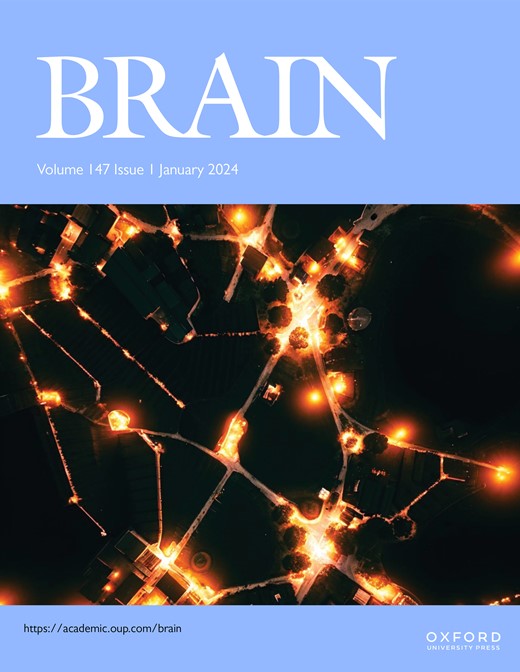寡聚腺苷酸合成酶1a通过结合细胞朊病毒蛋白抑制朊病毒感染。
IF 10.6
1区 医学
Q1 CLINICAL NEUROLOGY
引用次数: 0
摘要
朊病毒疾病是一种致命的神经退行性疾病,是由正常朊病毒蛋白(PrPC)错误折叠成其传染性β-富片异构体(PrPSc)引起的。传统上,朊病毒被认为不能引发强大的免疫反应,因为PrPC和PrPSc具有相同的初级结构。然而,最近的证据强调了I型干扰素(I- ifn)信号在宿主防御朊病毒传播中的关键作用。虽然我们之前已经证明干扰素调节因子3 (IRF3)激活的I-IFN在限制朊病毒入侵中起重要作用,但其保护作用的确切机制尚不清楚。在这里,通过体内和体外的朊病毒感染模型,我们发现2‘-5’寡聚腺苷酸合成酶1a (Oas1a)是干扰素刺激的基因,位于I-IFN受体的下游,可以在早期抑制朊病毒的侵袭。通过Oas1a基因敲除小鼠,我们发现Oas1a基因缺失显著加速了朊病毒疾病的进展,缩短了生存期,证明了其在体内的保护作用。与此一致的是,oas1a基因敲除小鼠的小鼠胚胎成纤维细胞对22L朊病毒感染的易感性显著增加,有效地消除了I-IFN治疗的抗朊病毒作用。此外,我们发现重组Oas1a在细胞外作用时,可以抑制朊病毒的繁殖,而不会激活传统的RNase L途径。在机制上,Oas1a直接结合PrPC,阻止其转化为PrPSc,从而限制了PrPSc在体外的积累。这些发现强调了IFN-Oas1a轴在限制朊病毒繁殖中的关键作用,并强调了其作为朊病毒疾病的新治疗靶点的潜力。本文章由计算机程序翻译,如有差异,请以英文原文为准。
Oligoadenylate synthetase 1a suppresses prion infection through binding to cellular prion protein.
Prion diseases are fatal neurodegenerative disorders caused by misfolding of the normal prion protein (PrPC) into its infectious β-sheet-rich isoform (PrPSc). Conventionally, prions were thought to be incapable of eliciting robust immune responses because PrPC and PrPSc share an identical primary structure. However, recent evidence highlights the critical involvement of type I interferon (I-IFN) signaling in host defense against prion propagation. Although we have previously shown that I-IFN, activated by interferon regulatory factor 3 (IRF3), plays an essential role in limiting prion invasion, the precise mechanisms underlying its protective effects remain unclear. Here, using in vivo and ex vivo prion infection models, we discovered that 2'-5' oligoadenylate synthetase 1a (Oas1a), an interferon-stimulated gene downstream of the I-IFN receptor, inhibits prion invasion at an early stage. Using Oas1a-knockout mice, we show that loss of Oas1a significantly accelerates prion disease progression and shortens survival, demonstrating its protective role in vivo. Consistent with this, mouse embryonic fibroblasts from Oas1a-knockout mice exhibited significantly increased susceptibility to 22L prion infection, effectively abrogating the anti-prion effects of I-IFN treatment. In addition, we found that recombinant Oas1a, when applied extracellularly, inhibited prion propagation without activating conventional RNase L pathways. Mechanistically, Oas1a directly binds PrPC, preventing its conversion to PrPSc and thus limiting PrPSc accumulation in vitro. These findings highlight the critical role of the IFN-Oas1a axis in limiting prion propagation and underscore its potential as a novel therapeutic target for prion diseases.
求助全文
通过发布文献求助,成功后即可免费获取论文全文。
去求助
来源期刊

Brain
医学-临床神经学
CiteScore
20.30
自引率
4.10%
发文量
458
审稿时长
3-6 weeks
期刊介绍:
Brain, a journal focused on clinical neurology and translational neuroscience, has been publishing landmark papers since 1878. The journal aims to expand its scope by including studies that shed light on disease mechanisms and conducting innovative clinical trials for brain disorders. With a wide range of topics covered, the Editorial Board represents the international readership and diverse coverage of the journal. Accepted articles are promptly posted online, typically within a few weeks of acceptance. As of 2022, Brain holds an impressive impact factor of 14.5, according to the Journal Citation Reports.
 求助内容:
求助内容: 应助结果提醒方式:
应助结果提醒方式:


